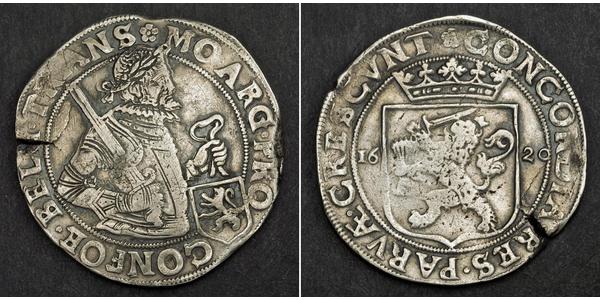(Venduta per $164.0)
1620, Netherlands, Overijssel. Large Silver Rijks Daalder (48 Stuivers) Coin. R!
Mint Year: 1620 Denomination: 48 Stuivers (Rijks Daalder) Reference: Davenport 4832, Delmonte 948, KM-13. Condition: Toned, weakly struck reverse, otherwise about XF! Weight: 28.58gm Diameter: 41mm Material: Silver
Obverse: Laureate and armored bust of William of Orange right, shouldering sword and holding arms on a rein. Legend: * MO . ARG . PRO . CONFOE . BELG . TRANS
Reverse: Crowned shield with dutch arms, splitting date (16-20). Legend: X CONCORDIA . RES . PARVAE . CRESCVNT Expanded: "CONCORDIA RES PARvae CREScunt" Translated: "Through unity little things grow (Union is strength)!"
The rijksdaalder (Dutch, "national dollar") was a Dutch coin first issued by the Republic of the Seven United Netherlands in the late 16th century during the Dutch Revolt. Featuring an armored half bust of the William the Silent, rijksdaalder was minted to the Saxon reichsthaler weight standard - 448 grains of .885 fine silver. Armored half bust rijksdaalders were struck until the end of the 17th century and were set to be equal to from 48 to 50 stuivers (the Dutch equivalent of shillings). They have circulated along with silver florins (28 stuivers), daalders (30 stuivers), leeuwendaalders (36 to 42 stuivers), silver ducats (48 stuivers), and ducatons (60 stuivers). With the disappearance of the original armored half bust rijksdaalder design, silver ducats and later 2½ guilders were started to be called rijksdaalders. Unification of the Dutch monetary system in the beginning 18th century introduced guilder and set rijksdaalders and silver ducats to be worth 2½ guilders.
The Republic of the Seven United Netherlands (Dutch Republic / Republic of the United Netherlands) was a republic in Europe existing from 1581 to 1795, preceding the Batavian Republic and ultimately the modern Kingdom of the Netherlands.
em>.
William I, Prince of Orange (April 24, 1533 — July 10, 1584), also widely known as William the Silent (Dutch: Willem de Zwijger), or simply William of Orange (Dutch: Willem van Oranje), was the main leader of the Dutch revolt against the Spanish that set off the Eighty Years' War and resulted in the formal independence of the United Provinces in 1648. He was born into the House of Nassau as a count of Nassau-Dillenburg. He became Prince of Orange in 1544 and is thereby the founder of the branch House of Orange-Nassau.
A wealthy nobleman, William originally served the Habsburgs as a member of the court of Margaret of Parma, governor of the Spanish Netherlands. Unhappy with the centralisation of political power away from the local estates and with the Spanish persecution of Dutch Protestants, William joined the Dutch uprising and turned against his former masters. The most influential and politically capable of the rebels, he led the Dutch to several successes in the fight against the Spanish. Declared an outlaw by the Spanish king in 1580, he was assassinated by Balthasar Gérard (also written as 'Gerardts') in Delft four years later.
William explained his conflict with king Philip II to the Council of State in the following way: "I can not approve that monarchs desire to rule over the conscience of their subjects and take away from them their freedom of belief and religion.".
Only 1$ shipping for each additional item purchased!














